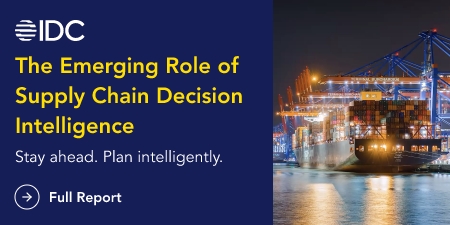
Walk into the boardroom of any global manufacturer today, and one thing is certain. Executives are not just talking about growth, expansion, or innovation. They’re talking about efficiency, cost control, and speed of decisions as a part of their core supply chain strategy.
A recent Gartner poll of senior supply chain executives put numbers to this shift. 68% ranked improving process efficiencies as their top priority. 56% emphasized faster decision-making. And 50% put reducing costs at the center of their AI and digitalization strategies. [1] These three themes—efficiency, speed, and cost—are all squarely in the wheelhouse of one capability that’s been overlooked for far too long: production scheduling.
It’s ironic. Most organizations have invested heavily in demand forecasting, supply planning, and even scenario planning. But when it comes to production scheduling—the function that translates those plans into day-to-day operational reality—many are still relying on spreadsheets, siloed tools, or outdated modules buried inside ERP systems.
And that’s where the cracks start to show.
Let’s discuss why production scheduling has become a strategic priority now, what companies are missing by leaving it underdeveloped, and how modern, AI-driven scheduling solutions can help them not just survive in today’s volatile world but thrive.
Executive Takeaway
Your supply chain is only as strong as its scheduling, which is why 68% of supply chain leaders now prioritize efficiency.
The Last Mile of Supply Chain Planning
Most companies have invested heavily in the front-end layers of planning:
- Demand Planning: Forecasting what the market needs.
- Supply Planning: Ensuring resources, suppliers, and logistics can deliver against the forecast.
- S&OP / IBP: Aligning plans with financial and business goals.
But when it comes to execution, the point where raw materials are transformed into finished goods, the chain often weakens. This “last mile” of planning, production scheduling, is where strategic intent must meet operational reality.
Too often, schedules are reactive rather than forward-looking. They’re adjusted manually, shaped by yesterday’s disruptions instead of tomorrow’s risks. And because ERP, MES, and spreadsheets each hold partial views, planners lack a single, real-time picture of what’s happening on the shop floor.
The result?
- High levels of work-in-progress inventory (WIP) are sitting idle.
- Inefficient machine utilization with frequent changeovers.
- Missed customer commitments when last-minute disruptions cascade through the system.
- A general sense that the factory is always “fighting fires” rather than executing smoothly.
Executives feel this in their KPIs, even if they don’t immediately point to scheduling as the cause. But as the Gartner poll shows, the very metrics they now prioritize are efficiency, speed, and cost, and that’s precisely where better scheduling has the most impact.
Executive Takeaway
Production scheduling is the last mile of planning. If it falters, even the best demand, supply, and S&OP strategies fail to deliver. Strengthening it restores cost discipline, agility, and service reliability.
5 Reasons Why Production Scheduling is a Top Boardroom Priority
You might ask, production scheduling has been around for decades, so why does it deserve renewed attention today?
You’re right, production scheduling is not a new concept. But supply chain experts advocate five reasons why it is essential for growing businesses today.
-
Economic Pressure and Cost Scrutiny
In a booming economy, when demand outpaces supply, companies can absorb inefficiencies on the factory floor. A bit of extra WIP here, an extra changeover there—no one raises eyebrows when margins are healthy.
But today’s context is different. Every operational cost is under the microscope. CFOs are pressing for reductions in hidden costs that accumulate daily. Small inefficiencies that once slipped under the radar are now material to the bottom line. Scheduling is a natural target, because it governs how resources, machines, and labor are deployed.
Executive Takeaway
Changeovers are a silent capacity drain—structured quick-changeover programs cut setup time by ~59% on average, unlocking margin without new capex. [2]
-
The Dynamic Nature of Disruptions
Supply chains are more volatile than ever. Materials don’t arrive as expected. Energy prices spike. A machine breaks down. Labor shifts change. Any of these can throw yesterday’s “optimal” schedule into chaos. And human intervention may not be quick enough to cope with the disruption. Without the ability to rapidly reschedule, companies end up overstocking, underproducing, or disappointing customers. Static schedules can’t keep up with a dynamic world.
Executive Takeaway
Agile scheduling turns chaos into continuity and keeps promises even when plans collapse.
-
The Rise of AI/ML and Decision Intelligence
Executives aren’t just interested in AI/ML as a buzzword. They want it to automate rapid decisions without breaking critical KPIs. Production scheduling is a perfect fit for this. It’s inherently data-rich, with countless variables, such as machine capacity, batch sizes, labor availability, and material arrivals.
Hybrid approaches combining ML techniques with heuristic and metaheuristic methods have already proven effective in navigating dynamic and uncertain production environments. But the next step is agentic AI:
- Autonomous rescheduling agents that instantly adjust the line when a machine breaks down—without waiting for human input.
- Simulation agents that run continuous scenario tests, surfacing the most profitable KPI trade-offs before decisions are made.
The result goes beyond speed. Agentic AI not only helps planners make faster decisions—it uncovers hidden capacity pockets and reveals new growth opportunities. In other words, production scheduling has moved from the back office to the boardroom.
Executive Takeaway
AI/ML-powered scheduling solutions can reduce scheduling effort by 96% from 90 minutes to 3.5 minutes per schedule. Thus, enabling speed and agility in the scheduling process [3]
-
Resilience Through Agile Scheduling
Resilience has become the boardroom word of the decade—and production scheduling is a core enabler. According to Gartner, 85% of supply chain professionals rank scheduling as critical for handling disruptions. [4] Companies that deploy agile scheduling practices witness:
- 30% less production downtime during unexpected disruptions. [5]
- Up to 65% shorter lead times when disruptions occur. [6]
- Improved on-time delivery rates, even under volatile conditions.
Agile scheduling doesn’t just mitigate disruption—it ensures continuity. By continuously monitoring shop-floor realities and automatically re-optimizing, companies move from firefighting mode to proactive stability. In industries like pharma or automotive, where downtime is costly and reputational risks are high, agile scheduling is the safety net that keeps the enterprise on its feet.
Executive Takeaway
Resilient scheduling reduces downtime, shortens lead times, and protects reputation when disruption strikes.
-
Quality, Capacity, and Competitive Advantage
Scheduling isn’t just about output but also competitive outcomes. A finely tuned schedule ensures:
- Higher resource utilization, squeezing more throughput from the same assets.
- Shorter lead times, creating agility to meet shifting demand.
- Consistent quality, by sequencing jobs intelligently to avoid rework, scrap, and bottlenecks.
The result is more than efficiency; it’s differentiation. Companies that harness scheduling effectively can accept more orders, promise faster delivery options, and improve product quality without incurring additional costs. This directly boosts customer satisfaction and creates a competitive moat. In fast-moving industries, the ability to reliably deliver what customers want, when they want it, is the ultimate market advantage.
Executive Takeaway
Intelligent scheduling turns consistency and agility into market share and stronger customer loyalty.
The New Playbook: AI-Driven Production Scheduling
If scheduling is now a boardroom priority, the question becomes how to approach it differently. Traditional methods such as manual adjustments, siloed tools, or static rules can no longer keep pace with today’s demands. What’s needed is a new playbook: an AI-driven framework that equips supply chains to make timely, intelligent decisions.
At its core, this framework brings together three pillars: Decision intelligence, integrated systems, and disruption management that transform scheduling from a back-office activity into a strategic enabler of efficiency, agility, and resilience. Here’s a look at the details of the solution framework:
Decision Intelligence
Harness AI, analytics, and scenario planning to transform raw scheduling data into actionable insights. For example:
- Early identification of risks, such as material delays or capacity bottlenecks, before they disrupt production.
- AI can simulate multiple scheduling scenarios in seconds, recommending the most cost-efficient one
- Scenario planning enables planners to test “what if” situations (e.g., a delayed material shipment) without disrupting live operations.
Integrated Systems
Scheduling can’t live in isolation. It must pull data from ERP, MES, and other planning tools into a single source of truth. Integration ensures:
- Real-time visibility across the supply chain and factory floor.
- No more decisions made on outdated or siloed data.
- A cohesive ecosystem where schedules align with both supply plans and customer demand.
Disruption Management
The world isn’t getting calmer; instead, it’s getting more dynamic. A scheduling solution must include built-in disruption management, such as:
- Risk quantification: simulating the impact of disruptions.
- Automated re-optimization: instantly adjusting schedules when disruptions occur.
- Agility and continuity: keeping the factory running smoothly even when surprises hit.
From Framework to Outcomes
A framework is only as strong as the results it delivers. With AI-driven production scheduling, the results map directly to the priorities executives care about most: efficiency, speed, and cost. But the real story comes alive when you see how these outcomes play out across industries. Here’s a look at the top outcomes as witnessed in diverse industry examples.
Operational Excellence
Production scheduling, at its heart, is about doing more with less. It minimizes waste, optimizes inventory, and ensures resources are used where they deliver the most value. Let’s take a look at some industry examples when production scheduling solutions helped global supply chains attain operational excellence.
Chemical Manufacturing: In a sector where margins are squeezed by volatile raw material costs and strict safety standards, production scheduling brings order to the chaos. Adaptive schedules combined with integrated systems enable chemical manufacturers to allocate resources optimally and keep communication flowing across plants. The payoff is greater visibility, accurate delivery timelines, and significantly improved order-service quality by up to 30%. [7]
Defense Manufacturing: Here, complexity comes from managing subcontractors alongside in-house production. By embedding subcontracting rules directly into the scheduling process, defense manufacturers strike a balance between what stays internal and what gets outsourced—making schedules not just efficient and up to 20% more accurate, [8] but executable in the real world.
AI-Driven Decision Excellence
Executives often say that speed and accuracy in decision-making can make or break supply chain performance. AI-driven scheduling is where this promise is realized. Here are some examples of how production scheduling brought about AI-driven decision excellence in different industries -
Aircraft MRO (Maintenance, Repair & Overhaul): In MRO, demand and capacity are moving targets—an unexpected inspection can derail carefully planned work. For example, AI-driven scheduling can be used to schedule over 30,000 operations through 100 work centers, [9] empowering teams to manage daily operations and adapt quickly to unexpected changes in demand or capacity. Teams can recalibrate in real time, re-sequencing jobs within minutes instead of days. That means fewer grounded planes and more reliable commitments to customers.
Consumer Goods: In fast-moving consumer industries, demand doesn’t wait. AI-powered scheduling can instantly weigh constraints like warehouse space, demand forecasts, and customer priorities to create optimized production plans in minutes. The result is not just faster planning—it’s a level of agility that matches the pace of the market.
Resilient Supply Chains
Resilience isn’t just about bouncing back—it’s about staying on your feet when the world keeps shifting under you. Production scheduling builds resilience by putting disruption management directly into daily operations. Let’s look at a few industry examples -
Automotive: Automotive manufacturers often juggle dozens of isolated workflows. AI-driven scheduling pulls them together into a synchronized system, generating end-to-end production plans within the same day. That means when demand shifts—or when a supplier misses a beat—the entire system can pivot quickly while staying aligned.
Life Sciences: Few industries feel the weight of compliance like pharmaceuticals. Unexpected downtime on a line doesn’t just risk lost revenue—it risks delayed FDA batch releases. Intelligent scheduling anticipates these risks and re-optimizes immediately, ensuring production continues without jeopardizing regulatory deadlines or patient trust.
Sustainable Growth
Sustainability is core to competitive supply chains today. Smart scheduling supports this imperative by reducing energy use, avoiding unnecessary runs, and aligning production with actual demand. Let’s examine how production scheduling enabled sustainable growth in these industry examples –
Consumer Goods: By cutting overproduction of perishable items, intelligent scheduling doesn’t just reduce waste—it keeps products fresh, and shelves reliably stocked, aligning operational efficiency with sustainability goals.
Paper and Ceramics: In energy-intensive sectors like paper pulp and ceramics, every production run carries significant power costs—intelligent scheduling sequences jobs to minimize energy spikes and align production with off-peak availability. The result is lower energy consumption, reduced operating costs, and a measurable contribution to sustainability goals.
These examples illustrate a simple truth: sustainability and profitability aren’t opposing forces—they reinforce each other when scheduling is done right. Whether it’s improving on-time delivery in chemicals, balancing subcontractors in defense, or keeping perishable goods fresh in CPG, production scheduling proves its value as the connective tissue between strategy and execution.
The Executive Lens: From Efficiency to Growth Opportunities
Executives don’t want more jargon or another layer of IT. They want clear answers to simple questions:
- How will this make us more efficient?
- How will this reduce costs?
- How will this help us make faster, better decisions?
Production scheduling answers all three—but it doesn’t stop there. Modern scheduling also creates new business opportunities:
- Harnessing hidden capacity: By better engaging underutilized resources, companies can take on more orders without additional capital investment.
- Enabling new service models: Smarter scheduling creates flexibility for offerings such as priority production windows or guaranteed rapid turnaround, giving customers differentiated service options that strengthen loyalty and revenue potential.
- Driving ESG impact: Cutting waste, energy use, and overproduction not only lowers costs but also strengthens a company’s sustainability credentials. It is an advantage in markets where brand reputation is tied to responsibility.
In short, production scheduling is more than an efficiency lever—it’s a growth engine. It connects high-level supply chain planning to real-world execution, where AI delivers visible, measurable impact in weeks, not years. And as the Gartner poll [1] makes clear, it addresses the very priorities CEOs and CFOs are now asking their CSCOs to deliver on: efficiency, speed, cost, and growth.
Looking Ahead: Instant Decisions in a Fast-Changing World
The world isn’t slowing down. Disruptions are multiplying. Costs are under scrutiny. Customers expect reliability even when supply chains are chaotic. That’s why production scheduling can’t wait any longer.
Companies that continue to treat it as an afterthought will struggle with inefficiencies, bloated inventories, and missed commitments. Companies that embrace AI-driven scheduling, however, will:
- Improve their most critical KPIs.
- Align directly with executive priorities.
- Build resilience that lasts beyond the next disruption.
- Build profitability by harnessing hidden capacity
- Achieve ESG goals
Tomorrow’s factories won’t just follow schedules—they will negotiate, adapt, and optimize in real time through agentic AI. The question is not whether you can schedule better, but whether your scheduling can think for itself.
At ICRON, this future is already taking shape. Our AI-driven decision intelligence platform equips manufacturers to automate rapid scheduling decisions, handle disruptions instantly, and uncover new capacity opportunities—turning scheduling from an afterthought into a growth engine.
Executive Takeaway
Companies that modernize scheduling see faster decisions, 50% lower WIP, and stronger resilience—can you afford to wait?
References
- Gartner Poll “CSCOs close the expectations-reality gap in your Supply Chain.”
- https://www.emerald.com/jmtm/article/34/9/84/1158205/Quick-changeover-design-a-new-Lean-methodology-to?utm_source=chatgpt.com
- https://www.sciencedirect.com/science/article/abs/pii/S0360835225003894
- Gartner's Supply Chain Technology User Wants and Needs Study, 2021
- McKinsey & Company, "The Agile Supply Chain: Competing in Volatile Markets," 2020
- Deloitte's Global Chief Procurement Officer Survey, 2022
- https://www.icrontech.com/resources/customer-stories/aksa-akrilik-improved-order-service-quality-by-30-percent-with-icron
- https://www.icrontech.com/resources/customer-stories/icron-enables-25-percent-resource-savings-in-defense-manufacturing
- https://www.icrontech.com/resources/customer-stories/saesl-s-extraordinary-journey-of-operational-excellence-with-icron













